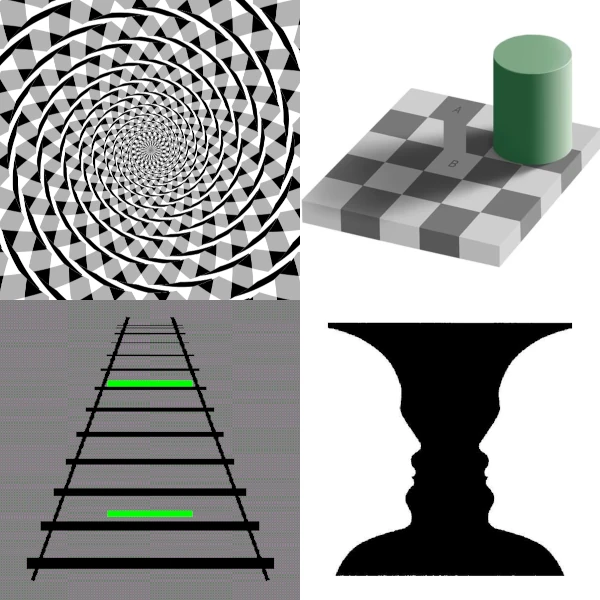
Image description: The "Checker shadow illusion of Adelson" was published by Edward H. Adelson in 1995. On this chessboard, squares A and B are exactly the same color. This incredible illusion can be verified by clicking on the image. This same-color illusion illustrates the cognitive step well. From a precise image of reality, our brain provides us with a coherent result that matches our knowledge. It interprets the colors, shapes, and movements of objects, then modifies or completes missing elements as needed to give things a certain coherence. In other words, it wants to see the sensory world as an intelligible world as it conceives, as it has understood, as it has been taught. Since birth, seeing is knowing, and our brain is blind until it learns to see. Credit: Edward H. Adelson Professor of Vision Science
Information from the external environment, in infinite quantity, is limited by the sensitivity of our sensory receptors such as those for vision, hearing, smell, or tactile perception.
This limited information allows our brain to process it quickly to provide us with a mental image that corresponds to a more or less accurate perception of reality. Thus, among all the data captured by our senses, only a portion can be processed at the conscious level.
This data filtering is also determined by attention and motivation. When we focus on a specific task (reading, listening, thinking, etc.), other environmental data not related to this task are ignored.
Our eyes, which are a product of evolution, cannot be mistaken because the light information limited to a specific spectrum is physically real. This information captured by the photoreceptors in our eyes is merely the reflection of photons off the objects in our environment. Like a mirror, our eyes are faithful to the light information that forms a concrete image on the retina. This information then triggers chemical reactions in the photoreceptors (cones and rods). The message is then transduced into nerve impulses (transduction) via bipolar neurons and then ganglion cells.
The axons of these neurons (optic nerve) connect to the visual cortex located at the back of the occipital lobe of the brain. It is here that visual information (image) completely disappears to be reconstructed into chemical signals (neurotransmitters) of an electrical nature. This information is processed globally with other sensory signals to produce an integrated multisensory representation of the environment. Evolution has chosen this mode of operation so that we can interact effectively with the world around us.
From this open window to the outside, our brain will select, decode, integrate, and interpret the characteristic events of the three-dimensional colored scene (visual stimulus).
Thus, what we call "vision" is just a brain interpretation of electrical signals dependent on our mental frameworks. Indeed, the same image can be interpreted differently by different individuals because they have not experienced the same events at the same times in their lives.
We do not see with our eyes but with our brain!
According to perception psychologists, this interpretation goes through several stages (sensory, perceptual, and cognitive).
The sensory stage allows us to perceive, through our specialized receptor cells, a vast amount of light, auditory, olfactory, and tactile information from the environment.
The perceptual stage enables our brain to select a portion of the sensory data such as shapes, colors, and movements.
The cognitive stage will assign a coherent meaning to the information. This concept will be created based on our prior knowledge, in other words, our learning. For example, when we look at the thousands of randomly scattered stars in the night sky, we mainly notice those that form asterisms that we call constellations (Big Dipper, Aries, Taurus, Gemini, etc.). Our brain immediately detects geometric shapes (lines, circles, squares, rectangles). These shapes give meaning to our environment as they help us navigate space. Throughout life, the brain learns to see through neurobiological mechanisms (perception, motor skills, language, memory, reasoning, emotion, etc.).